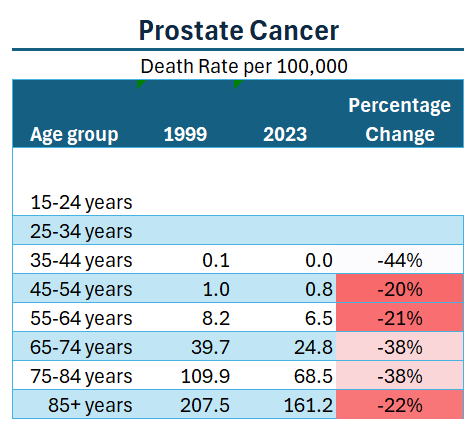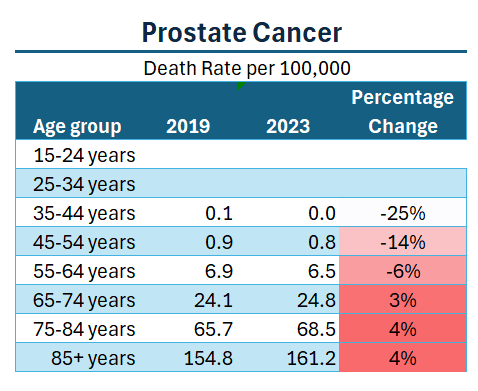Movember 2024: Prostate Cancer Mortality Trend Update, 1968-2023
With a focus on some pandemic effects
My background with Movember can be seen here:
Here are the places you can donate to the Movember Foundation, which supports men’s health, specifically focusing on prostate cancer, testicular cancer, and men’s mental health:
Mary Pat Campbell’s MoSpace – a place to donate at Movember itself
My Movember Facebook fundraiser – my officially linked fundraiser, if this works better for you
And here’s a QR code if that works better for you:
Prostate Cancer Top-Level Trend 1968-2023
As usual, I start out at the very highest level in looking at mortality rate trends — both crude rates (which is influenced by the aging of the population) and age-adjusted rates (which removes that influence).
There has been great news since the peak of prostate cancer mortality in the early 1990s. With increased screening and improved treatments, prostate cancer mortality has decreased significantly in the U.S.
However, you can see that the age-adjusted death rate, which is the high-level mortality metric I use the most, has stalled out for the last decade.
What might be going on?
Age group trends for prostate cancer mortality
Let’s break it out by age groups, because it might show us a little better what’s going on.
The age-adjusted death rate collapses a lot of information into a single metric, but taking a weighted average of death rates, with the weights staying constant. So some of the rates can be going up for some age groups, while others are going down… and that leads to the whole age-adjusted death rate stalling out.
This just shows the rates — and you can see the very different rate levels for the different age groups. It is difficult to tell the trend for all the age groups, due to the scale, but it is obvious that there was a stalling out of improvement in the death rates for the oldest age groups.
But let’s look at the good news first — very long-term, the death rates have much improved since 1999:
There’s nothing special about 1999, other than that’s when the ICD-10 code went into effect. But you can see that there was a large reduction in death rates across the board. Great news!
[and yeah, ignore that it puts red on what is actually good news — those are all reductions, very large reductions, in death rates — that’s just an artifact of conditional formatting in Excel.]
However, if we focus solely on the pandemic period, the narrative shifts:
Only a slight increase in mortality for the oldest age groups, but this doesn’t sit well.
Decadal improvement trends by age group
Let’s pull back to a larger period, covering the 50 years of 1973-2023. If we look at how the death rates changed for each decade, we see the first two decades were pretty bad, with increasing rates for most of the age groups, with great improvement over the next two decades….
….and then the last decades was a stalling out.
Yes, it was down a lot at the youngest age group on this graph, which is good, but as you can see from the tables above, the age 45-54 year-old group has a very low death rate from prostate cancer. Even in 1999, it was very low.
During the pandemic, here have been the changes.
This is the percentage change compared to 2019.
That the death rate has gotten worse compared to 2019 is concerning to me — I wonder if older cancer patients have missed treatments because they haven’t been able to get transportation to their appointments, for instance.
Stuart told me in 2020 that he noticed far fewer people were at the cancer center in White Plains when he went. It’s not just a matter of people dying of COVID (though some did, of course), but that they lost their ride or were afraid to go to hospitals or other healthcare facilities for fear of being exposed to infection. Stu told me that in 2020, he was often the only patient there. He didn’t want to miss any of his treatments. As a metastatic cancer patient, he couldn’t afford to miss one.
But some may not have had choices, in losing transportation, or having treatment canceled due to their own COVID illnesses, or even the medical staff being unavailable due to their own illnesses.
Then there is the concern of missed screenings.
I hope this prostate cancer death trend is only a momentary bobble, but I don’t know.













Thank you for your efforts!